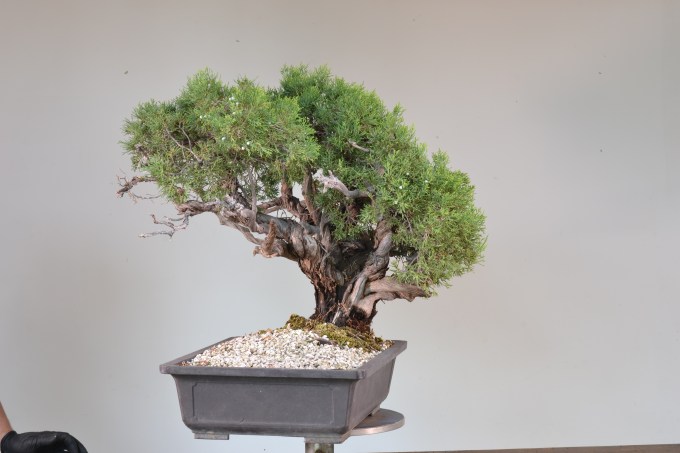Tree-like Juniper Styling
Often we style a juniper as an abstract form. Many species are, after all, shrubs, and have no clear form. And then, deadwood features often go off into sculpural wonderlands quite unrelated to trees, other than being made of wood.
This Rocky Mountain Juniper, Juniperus scopulorum, was collected by Steve Varland of Backcountry Bonsai. When I saw it I was surprised by its similarity to a naturally growing, 25′ tall, upright Western or Sierra Juniper, limbs rising, twisting all over the place. It looked like an actual tree juniper, in miniature.
That locked in our styling idea. And it didn’t appear like a difficult one to manage, finding an appropriate front and lightly massaging the branches with wire would be enough. In fact when John was applying the wire he laughed and said, ‘Are you sure this hasn’t been wired before?’ Many of the branches required only modest adjustment.
This past week we styled it. Hope you enjoy the photo essay-

The raw tree, with a hand for scale

Rotating to give a sense of the whole…

…another view

This was one of our original front ideas

But on cleaning the live veins more shari was discovered, and then this front seemed more active, with the base showing shari as well.

And here it is after the first styling. There are no less than 4 trunks / leaders on this tree. From this front we were able to get three trunks visible, and with a tip to the left allow one of those dominance, and suggest flow as well. Although the tree-like form was the thing that intrigued me about it, a supporting intrigue was the snarls of jin beneath the canopy. This is exactly what I’ve seen on tree junipers like the Sierra Junipers in Yosemite. Often we style junipers with the jin to the exterior of the form, or on top, which is exciting and I do that as well, and yet dead branches beneath higher branches is a bit more accurate out in the wilds with the tree-type junipers, having died off underneath the higher ones. Though I rarely shorten or manipulate jins, I don’t like hard rules, either, and in this case shortening a couple of the long straight ones brought more attention to the remarkable twists in the trunks. Finding a balance in all the competing elements, and choosing which is most important while not losing complexity is not an easy dance. Hope you enjoyed our attempt.

6 Comments
Michael,
Great work! And thanks for ‘justifying’ the retention of interior jin; certainly a more natural look.
Jim
wonderful styling Michael with a little help from John
💥👍 Gorgeous transformation…thanks for sharing ❣️ Carolyn Fitz
Sent from my iPad
>
Hi Michael,
Sometimes one of the downsides of looking at photos of bonsai is the lack of scale. I am often surprised how big or small a tree is when a person is in shot. The hand in the corner of these shots made me think of this. I wonder if you could include more photos on your blog with your lovely noggins in them.
Cheers
Symon
AMAZING!!!!!!!
On Fri, Oct 23, 2020 at 8:13 AM Michael Hagedorn wrote:
> crataegus posted: ” Often we style a juniper as an abstract form. Many > species are, after all, shrubs, and have no clear form. And then, deadwood > features often go off into sculpural wonderlands quite unrelated to trees, > other than being made of wood. This Rocky Mou” >
Magnificent! Great work.. I’ll like to see more pictures and pot selection. Thank you.